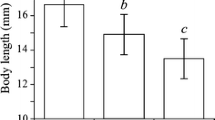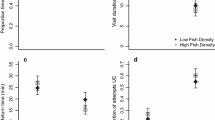Abstract
We investigated the fitness and community consequences of behavioural interactions with multiple predators in a four-trophic-level system. We conducted an experiment in oval flow-through artificial-stream tanks to examine the single and interactive sublethal effects of brook trout and stoneflies on the size at emergence of Baetis bicaudatus (Ephemeroptera: Baetidae), and the cascading trophic effects on algal biomass, the food resource of the mayflies. No predation was allowed in the experiment, so that all effects were mediated through predator modifications of prey behaviour. We reared trout stream Baetis larvae from just before egg development until emergence in tanks with four treatments: (1) water from a holding tank with two brook trout (trout odour), (2) no trout odour + eight stoneflies with glued mouthparts, (3) trout odour + stoneflies and (4) no trout odour or stoneflies. We ended the experiment after 3 weeks when ten male and ten female subimagos had emerged from each tank, measured the size of ten male and ten female mature nymphs (with black wing pads), and collected algal samples from rocks at six locations in each tank. To determine the mechanism responsible for sublethal and cascading effects on lower trophic levels we made day and night observations of mayfly behaviour for the first 6 days by counting mayflies drifting in the water column and visible on natural substrata in the artificial streams. Trout odour and stoneflies similarly reduced the size of male and female Baetis emerging from artificial streams, with non-additive effects of both predators. While smaller females are less fecund, a fitness cost of small male size has not been determined. The mechanism causing sublethal effects on Baetis differed between predators. While trout stream Baetis retained their nocturnal periodicity in all treatments, stoneflies increased drift dispersal of mayflies at night, and trout suppressed night-time feeding and drift of mayflies. Stoneflies had less effect on Baetis behaviour when fish odour was present. Thus, we attribute the non-additivity of effects of fish and stoneflies on mayfly growth to an interaction modification whereby trout odour reduced the impact of stoneflies on Baetis behaviour. Since stonefly activity was also reduced in the presence of fish odour, this modification may be attributed to the effect of fish odour on stonefly behaviour. Only stoneflies delayed Baetis emergence, suggesting that stoneflies had a greater sublethal effect on Baetis fitness than did trout. Delayed emergence may reduce Baetis fitness by increasing risks of predation and parasitism on larvae, and increasing competition for mates or oviposition sites among adults. Finally, algal biomass was higher in tanks with both predators than in the other three treatments. These data implicate a behavioural trophic cascade because predators were not allowed to consume prey. Therefore, differences in algal biomass were attributed to predator-induced changes in mayfly behaviour. Our study demonstrates the importance of considering multiple predators when measuring direct sublethal effects of predators on prey fitness and indirect effects on lower trophic levels. Identification of an interaction modification illustrates the value of obtaining detailed information on behavioural mechanisms as an aid to understanding the complex interactions occurring among components of ecological communities.
Similar content being viewed by others
Author information
Authors and Affiliations
Additional information
Received: 20 March 1997 / Accepted: 29 September 1997
Rights and permissions
About this article
Cite this article
Peckarsky, B., McIntosh, A. Fitness and community consequences of avoiding multiple predators. Oecologia 113, 565–576 (1998). https://doi.org/10.1007/s004420050410
Issue Date:
DOI: https://doi.org/10.1007/s004420050410




